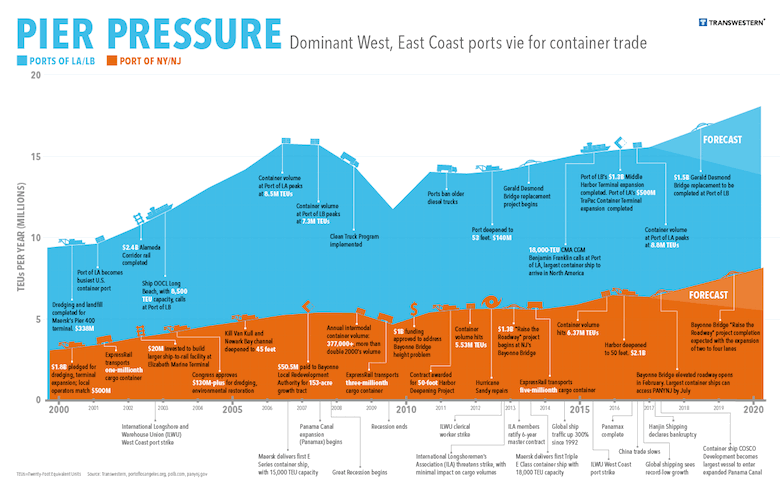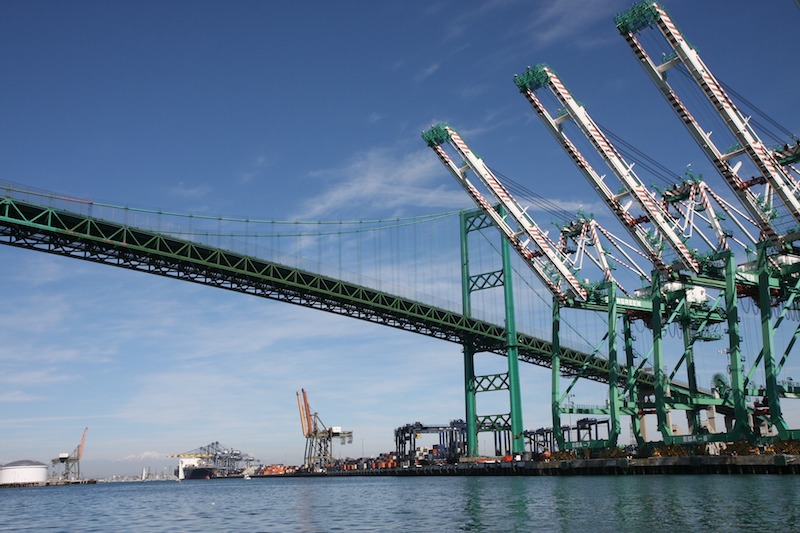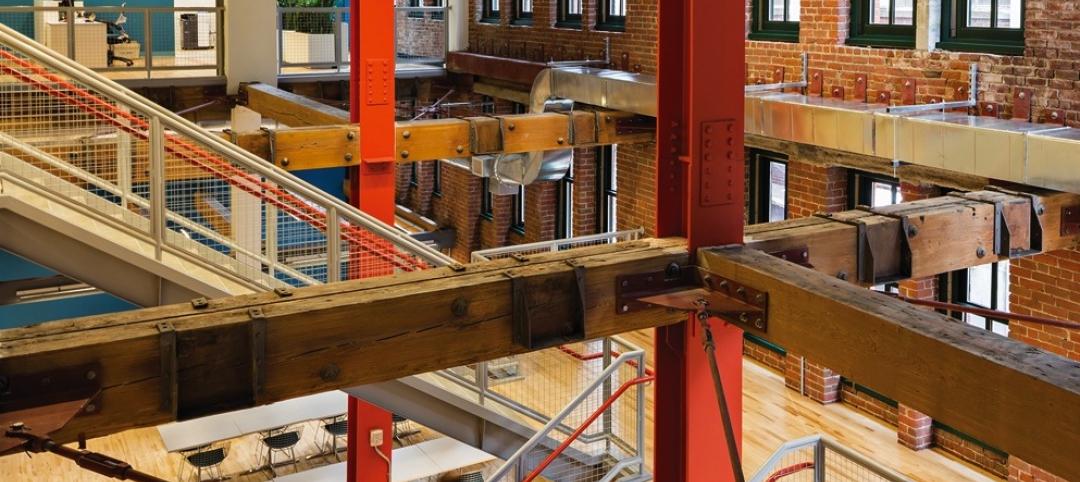The $5 billion Panama Canal expansion (Panamax) opened in late June 2016, making direct access of larger ships from China and elsewhere to America’s East Coast ports more expedient.
But well before that opening, three dominant U.S. ports were engaged in large-scale growth efforts to hold onto and increase their share of that anticipated container trade.
Ports of Los Angeles and Long Beach, Calif., and the Port of New York and New Jersey have spent the past two decades deepening channels, raising bridges, and investing in terminal automation and dockside infrastructure (see chart).
Since Panamax opened, the Port of Long Beach has completed a $1.3 billion Middle Harbor Terminal expansion; and the Port of Los Angeles—whose container volume peaked this year at 8.8 million Twenty-Foot Equivalent Units (TEUs)—completed a $500 million TraPac Container Terminal Expansion.
The Port of New York/New Jersey spent $2.1 billion to deepen its harbor to 50 feet. And by opening an elevated Bayonne Bridge, the largest container ships now have access to the Port of NY/NJ.
CLICK IMAGE TO ENLARGE
 This chart shows the relationship between the development and construction actvities at America's three largest ports— Los Angeles, Long Beach and New York/New Jersey—and their increases in container volumes. Image: Transwestern.
This chart shows the relationship between the development and construction actvities at America's three largest ports— Los Angeles, Long Beach and New York/New Jersey—and their increases in container volumes. Image: Transwestern.
Despite predictions that the Panama Canal widening would disseminate some shipping away from major ports to an array of smaller markets on the Gulf and East Coasts, the ports of Los Angeles and Long Beach and Port of NY/NJ “have retained their stature as the dominant entry points for containerized merchandise and manufacturing components to be assembled domestically,” observe two executives from Transwestern, the national real estate firm.
In its recent edition of “Ask the Expert,” Transwestern’s Director of Research for New Jersey Matthew Dolly and Research Manager for Southern California Michael Soto point out that, as activity at these ports increases, rent rates have been rising, but still take a back seat to transportation costs and access to labor as factors determining where businesses select space.
Panamax has caused some shifts in where ships from Asia and elsewhere unload in the U.S. The Ports of Long Beach and Los Angeles, America’s two largest ports, once received half of all containerized goods entering the U.S. Last year they handled a combined 15.6 million TEUs, or just under one-third of national volume. The authors state that these ports’ combined volume is projected to increase by 3.9% annually through 2040.
The Port of NY/NJ recognized opportunities from increasing shipping travel through the Suez and Panama Canals. Last year, its annual volume peaked to 6.25 million TEUs, or 13% of U.S. volume, and became America’s third-largest port. The authors say that this port has been “catching up” to its West Coast competitors.
In general, busy ports are catalysts for industrial and commercial development around them. This is even truer now that several ports have positioned themselves to receive higher container volumes from giant ships.
About one-third of containerized cargo entering the L.A and Long Beach ports stays in the region to serve 20 million local consumers. And given New York and New Jersey’s population density, they are lucrative destinations for imported goods, many of which travel through the Suez Canal.
“As the world’s concentration of low-cost labor shifts from China to India and other markets bordering the Indian Ocean, the volume of goods passing through the Suez Canal to enter the U.S. via East Coast ports will likely increase,” the Transwestern authors write.
Warehouse and distribution spaces on both coasts are at a premium. And, say the authors, it appears that retailers and manufacturers seem willing to accept higher rents to be closer to those distribution points nearer the ports. “Developers must decide how far away from the region’s population center they can build before the distance makes a location impractical for distribution centers,” the authors write.
The ports in southern California and the New York metro region have committed to maintaining and improving their surrounding infrastructures to be able to handle the transportation of high cargo volumes. Last year, for example, New Jersey’s Transportation Trust Fund earmarked $400 million in annual funding for road, bridge and transit improvements.
In Southern California, major infrastructure improvements include the $1.5 billion replacement of the Gerald Desmond Bridge in Long Beach, to allow access to the port for the tallest container shops. The new bridge will have six lanes (two more than the existing span), as well as a bike lane and observation deck. It’s scheduled for completion next year, at which point it will span 8,800 feet.
Related Stories
| Aug 5, 2014
Will driverless cars kill the parking structure?
A report from Deloitte highlighted how driverless cars could dramatically alter car ownership in the future, pushing the pendulum from ownership to rentals and ride sharing.
| Jul 28, 2014
Reconstruction market benefits from improving economy, new technology [2014 Giants 300 Report]
Following years of fairly lackluster demand for commercial property remodeling, reconstruction revenue is improving, according to the 2014 Giants 300 report.
| Jul 28, 2014
Reconstruction Sector Construction Firms [2014 Giants 300 Report]
Structure Tone, Turner, and Gilbane top Building Design+Construction's 2014 ranking of the largest reconstruction contractor and construction management firms in the U.S.
| Jul 28, 2014
Reconstruction Sector Engineering Firms [2014 Giants 300 Report]
Jacobs, URS, and Wiss, Janney, Elstner top Building Design+Construction's 2014 ranking of the largest reconstruction engineering and engineering/architecture firms in the U.S.
| Jul 23, 2014
Architecture Billings Index up nearly a point in June
AIA reported the June ABI score was 53.5, up from a mark of 52.6 in May.
| Jul 21, 2014
Economists ponder uneven recovery, weigh benefits of big infrastructure [2014 Giants 300 Report]
According to expert forecasters, multifamily projects, the Panama Canal expansion, and the petroleum industry’s “shale gale” could be saving graces for commercial AEC firms seeking growth opportunities in an economy that’s provided its share of recent disappointments.
| Jul 18, 2014
Contractors warm up to new technologies, invent new management schemes [2014 Giants 300 Report]
“UAV.” “LATISTA.” “CMST.” If BD+C Giants 300 contractors have anything to say about it, these new terms may someday be as well known as “BIM” or “LEED.” Here’s a sampling of what Giant GCs and CMs are doing by way of technological and managerial innovation.
| Jul 18, 2014
Top Construction Management Firms [2014 Giants 300 Report]
Jacobs, Barton Malow, Hill International top Building Design+Construction's 2014 ranking of the largest construction management and project management firms in the United States.
| Jul 18, 2014
Top Contractors [2014 Giants 300 Report]
Turner, Whiting-Turner, Skanska top Building Design+Construction's 2014 ranking of the largest contractors in the United States.
| Jul 18, 2014
Engineering firms look to bolster growth through new services, technology [2014 Giants 300 Report]
Following solid revenue growth in 2013, the majority of U.S.-based engineering and engineering/architecture firms expect more of the same this year, according to BD+C’s 2014 Giants 300 report.















